Enbeeco 7x50 Monokular mit KompassHierbei handelt es sich um ein 7x50 Monokular mit Porro-I-Prismen und vergüteter Optik. Die britische Firma Enbeeco (Kurzform für 'Newbold & Bulford Ltd.' bzw. Co. London) hat dieses Monokular nach dem 2. Weltkrieg für das Militär bzw. die Marine hergestellt bzw. in Japan fertigen lassen. Das Aluminiumgehäuse hat eine Trageöse und ist ummantelt mit Rauhlack. Es hat eine umstülpbare Gummiaugenmuschel für Brillenträger. Der Dioptrienausgleich geht von -4 bis +2.Auf dem Deckel ist ein Sehfeld von 7,1° angegeben (s. Foto), es wiegt 500g, die Gesamtlänge beträgt ca. 18cm, das Gehäuse ist ca. 62x62x85mm, der Objektivtubus noch einmal 52mm lang mit einem Durchmesser von 60mm außen. |
Enbeeco 7x50 Compass Bearing MonocularThis is a 7x50 monocular with a porro I system and coated optics. The British company Enbeeco (shortened form of 'Newbold & Bulford Ltd. or Co.'London ) must have produced this monocular after WWII for the Army or Navy. The aluminium prism body has a strap lug and a crinkle paint covering. There is a foldable rubber eye-cup for spectacle weares. dioptre adjustment ranges from +2 to -4.The top lid states a f.o.v. of 7.1° (s. pic). It weighs 500g. Its overall length is 18cm, the housing is 62x62x85mm, the objective tube is an additional 52mm long and has a diameter of 60mm. |
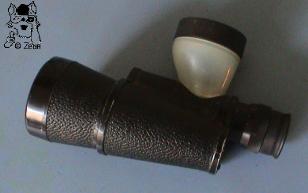
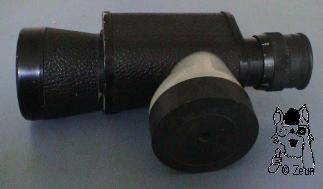
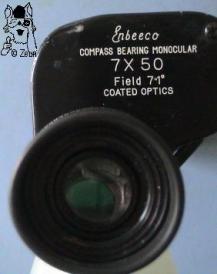

| Das Besondere an dem Monokular ist natürlich der eingebaute Kompass. Dafür wurde das Gehäuse vor dem Okularende aufgebohrt und ein lichtdurchlässiger weißer Plastiktrichter (steht 45mm hervor) eingesetzt. In diesem befindet sich ein kleines Objektivröhrchen, dessen Bild ein Winkelprisma in das Okular umleitet. Am 55mm breiten Ende des Trichters ist ein Flüssigkeits-gelagerter Kompass eingesetzt. Der Trichter ist mit einem schwarzem Kunststoffdeckel verschraubt (Beschriftung: "Pat. App. for"). Durch die Optik mit Winkelprisma wird die Skala des Kompasses beim Beobachten im Okular sichtbar. Ein senkrechter Haarfaden (Draht) im Brennpunkt dient als Wertemarkierung der Gradabweichung von Nord (s. Foto). Um ein gut ablesbares Kompassbild zu erhalten, braucht es geeignete Lichtverhältnisse. | The monocular's special feature is, of course, the built-in compass. The body was sawn open near the ocular end, and a luminiscent white plastic funnel (protruding 45mm) was fixed there. There is a small objective tube in the funnel. Its image is redirected into the ocular by a angled prism. A floating compass is put into the 55mm wide end of the funnel. The latter is closed by a black plastic lid marked "Pat. app. for". The optic tube with its angled prism the compass' scale is shown within the ocular. A vertical hair wire at the focal point serves as a marking line to read the deviation from north in degrees (s. photo). You need appropriate lighting conditions to read the displayed image of the scale. |
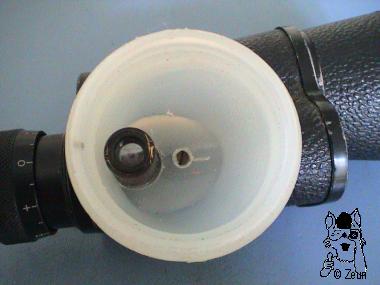
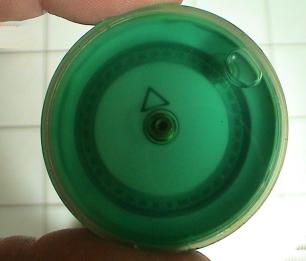
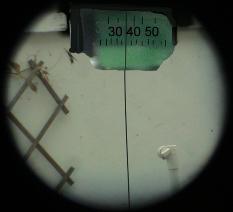
| Das Monokular gab es auch mit einem Haltegriff am Kompass (s. Foto). Ein ähnliches Modell ist das "Enbeeco 7x50 Tele-Clino". |
This monocular came also with a handle attached to the compass (s. photo). A similar monocular is the "Enbeeco 7x50 Tele-Clino". |
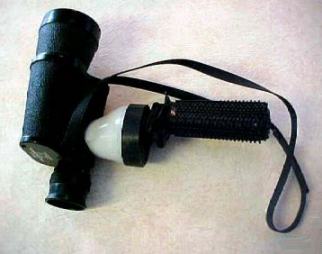
Fotos: Zeun, Ebay

